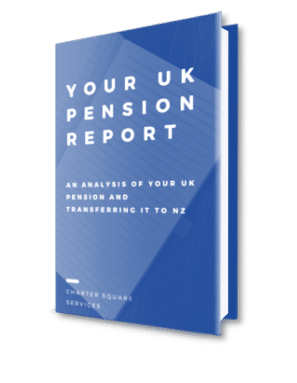If you’ve worked in the UK and are now living in New Zealand, you might be eligible to make Voluntary Additional Contributions (VACs) to increase your future UK State Pension. On paper, that sounds like a solid investment. But is it actually worth it?
We modelled nine different scenarios based on age, years you’ve already contributed into building up the state pension in the UK, and the number of years that you will pay for (you can pay a maximum of 35 to receive the full UK pension) — factoring in:
- NZ taxation – you receive an after tax income stream in New Zealand
- UK inflation – assumed to be running at 2.5% until the time that you receive the pension which is then frozen as you live overseas
- An 8.4% after-tax return benchmark (based on 40 years of S&P 500 data)
- That you have been out of the UK for 10 years and that is the period that you can legitimately back date for the first lump-sum contribution
- We have assumed that everyone will need to pay for Class 3 contributions (as just about everyone will be in this category) this is £923 a year
- Each year of additional voluntary contributions will buy you 1/35th of the UK state pension
📊 Summary of Results
| Age | Years Already Paid in | Years to Pay | Cost (£) | Future Pension (£) | NPV (£) | Years to break even |
|---|---|---|---|---|---|---|
| 40 | 5 | 30 | 27,690 | 270,197 | (2,472) | Never |
| 40 | 10 | 25 | 23,075 | 225,164 | (3,974) | Never |
| 40 | 20 | 15 | 13,845 | 135,098 | (5,087) | Never |
| 50 | 5 | 26 | 23,998 | 182,934 | 6,319 | 29 |
| 50 | 10 | 25 | 23,075 | 175,898 | 5,669 | 29 |
| 50 | 20 | 15 | 13,845 | 105,539 | 698 | 36 |
| 60 | 5 | 16 | 14,768 | 87,943 | 11,786 | 15 |
| 60 | 10 | 16 | 14,768 | 87,943 | 11,786 | 15 |
| 60 | 20 | 15 | 13,845 | 82,447 | 10,779 | 15 |
💰 What Does the “Cost” Actually Buy You?
That “Cost” column is what you’d pay — often as a lump sum — to buy the option of getting additional pension payments in the future. These are the additional voluntary contributions that you need to make to the UK government.
These payments will produce an additional future pension income stream (as you are effectively buying an additional pension increase off the UK government). Based on a life expectancy of 87 the additional total future pension payments are shown in the column Future Pension (£). In most instances these increases in future pension look eye-wateringly large.
But there’s a number of catches:
- If UK pension payments end up getting offset against your New Zealand Superannuation (as they were prior to 2020), you may see no additional income. The money you paid would be lost. In that case, you’ve just bought a one-way ticket to nothing — no refund, no ownership, no benefit.
- If the UK government introduces any future residency requirement you may never receive the UK pension (New Zealand has these requirements already)
- When you actually look at the net present value (NPV) of the costs that you need to pay over time against the income you receive the benefits might not actually be that great. This is clearly shown in the NPV column on the table. A positive NPV is a good investment, a negative one bad and zero is neutral.
🧠 Younger? Consider Investing Instead
If you’re in your 40s, the model shows you never break even based on a 8.4% after tax return. That means you’d be better off investing the same amount privately, where you:
- Retain full ownership of the money
- Get higher returns (historically)
- Aren’t relying on future government policy not changing
⏳ Why “Years to Breakeven” Matter
That column tells you how many years legislation must stay exactly the same — no changes to NZ Super rules, no restrictions on UK overseas pensions — for you to even start receiving value.
For example, if you’re 50 and break even in year 29, you’ll need to wait until you’re nearly 80 before you’re actually ahead.
That’s a big bet on two governments not making any changes in the next three decades.
✅ So Who Is It Worth It For?
- People in their 60s with close to 35 years of UK contributions
- Those who don’t rely on NZ Super, or plan to return to the UK
- People willing to take the regulatory risk and have extra money to spare to do so
Want to explore your personal breakeven point? Drop your age and UK contribution years, and we’ll simulate it.
For those interested in seeing the results at a lower discount rate we have modelled that below at a 5% annual after tax return.
📊 Results under a 5% discount rate
| Age | Years Already Paid in | Years to Pay | Cost (£) | Future Pension (£) | NPV (£) | Years to Break even |
|---|---|---|---|---|---|---|
| 40 | 5 | 30 | 27,690 | 270,197 | 25,662 | 34 |
| 40 | 10 | 25 | 23,075 | 225,164 | 19,852 | 35 |
| 40 | 20 | 15 | 13,845 | 135,098 | 9,971 | 37 |
| 50 | 5 | 26 | 23,998 | 182,934 | 31,932 | 23 |
| 50 | 10 | 25 | 23,075 | 175,898 | 30,387 | 23 |
| 50 | 20 | 15 | 13,845 | 105,539 | 16,292 | 24 |
| 60 | 5 | 16 | 14,768 | 87,943 | 26,151 | 13 |
| 60 | 10 | 16 | 14,768 | 87,943 | 26,151 | 13 |
| 60 | 20 | 15 | 13,845 | 82,447 | 24,336 | 13 |



